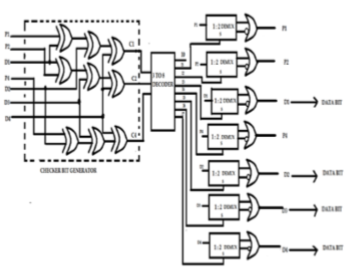Design of Hamming Code Encoding and Decoding Circuit Using Transmission Gate Logic
Also Available Domains Communications|Tanner EDA
Project Code :TVMABE108
Objective
In this paper, the Hamming code encoder and decoder circuit is implemented using transmission gate logic. The architecture is simulated with different technologies (16nm, 22nm, 32nm, and 45nm) with the help of TANNER EDA Tool for the study of total power dissipation of the circuit.
Abstract
In this paper, the Hamming code encoder and
decoder circuit is implemented using transmission gate logic. The architecture
is simulated with different technologies with the
help of TANNER EDA Tool for the study of total power dissipation of the
circuit. The analysis shows that with the decrease of channel length, there is an decrease of power dissipation in 45nm compared to 180nm
250nm in encoder and decoder circuit.
NOTE: Without the concern of our team, please don't submit to the college. This Abstract varies based on student requirements.
Block Diagram

Specifications
Software Requirements:
- Tanner EDA
- Technology files:180nm
Hardware Requirements:
- Microsoft® Windows XP
- Intel® Pentium® 4 processor or Pentium 4 equivalent with SSE support
- 512 MB RAM
- 100 MB of available disk space
Learning Outcomes
- Introduction Communication systems
- Error correction codes
- Significance of error correction codes in communication systems
- Transistors & its applications
- Types of Transistors
- Logic Gates using Transistors
- Pull Up and Pull Down networks
- Importance of Transistors
- MOS Fundamentals
- NMOS/PMOS/CMOS Technologies
- How to design circuits using Transistor logic?
- Transistor level design for Error correction codes.
- How to design low power, high speed area efficient transistor level circuits?
- Drawbacks in CMOS technology
- Scope of Error Correction Codes in today’s world
- Applications in real time
- Tanner EDA tool for design and simulation
- Solution providing for real time problems
- Project Development Skills:
- Problem Analysis Skills
- Problem Solving Skills
- Logical Skills
- Designing Skills
- Testing Skills
- Debugging Skills
- Presentation skills
- Thesis Writing Skills
Demo Video
Related Topics


 Paper Publishing
Paper Publishing
